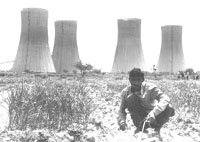Thriving on bad air
 increasing levels of carbon dioxide (CO2) in the atmosphere could result in some fundamental changes in the growth pattern of plants, say scientists at the University of Michigan Biological Station, usa. While studying the impact of atmospheric conditions in near future, these scientists have discovered that trembling aspen trees grow bigger and faster while producing more roots and less nutritious leaves. After such findings, scientists predict dramatic ecological changes in future. Peter Curtis, botanist at the Ohio State University and former principal of the Michigan studies says, "This hits the base of the food chain."
increasing levels of carbon dioxide (CO2) in the atmosphere could result in some fundamental changes in the growth pattern of plants, say scientists at the University of Michigan Biological Station, usa. While studying the impact of atmospheric conditions in near future, these scientists have discovered that trembling aspen trees grow bigger and faster while producing more roots and less nutritious leaves. After such findings, scientists predict dramatic ecological changes in future. Peter Curtis, botanist at the Ohio State University and former principal of the Michigan studies says, "This hits the base of the food chain."
The carbon from the co2 provides an essential building block for the ecosystem. During photosynthesis, plants convert co2 into sugars and other compounds that though low on nutrition provide energy to herbivores. These compounds are then passed on to the parasites and carnivores that subsist on herbivores, and the cycle continues.
Corroborating a statement of Peter Curtis that "everything with a few exceptions depends on plants." Researcher David Karowe says, "The thinking of most ecologists is, if one component is affected, all are."
Since the industrial revolution the level of atmospheric carbon dioxide is increasing. Now they are rising more rapidly with more fuel consumption and growth of population at anticipated rates, causing global warming. Says station director, James Teeri, "A change that rapid, as far as we know, has never happened."
Teeri's team has been growing trees inside special open-topped plastic chambers. Half the chamber was filled with air containing co2 concentrates and half held current atmospheric air. Most of the studies, which started in 1990, have involved aspen trees, "the laboratory rat of treedom," according to Teeri, because it is North America's most widespread and most studied tree. All of the tests were of a year's duration, except the last test where the results are still being analysed.
The studies revealed that the trees exposed to increased co2 levels grew 25 to 35 per cent larger than those raised in current conditions. The trees sprouted a quarter more leaves and roots. "The co2 acted like a hormone causing developmental changes," notes Teeri.
Greenhouse growers have long known that an extra dose of co2 makes plants grow bigger and faster. The trees in the Michigan test which were treated to super-elevated amounts of the gas showed other changes. Their leaves stayed active for a longer period of time, though the reasons are not yet known.
The roots of the trees exposed to higher levels of co2 died sooner than the control-tree roots. The roots of the high trees exposed to high co2 levels deposited more amounts of carbon in the soil when they decayed, because of their shorter life span and more abundant numbers.
The increased level of co2 in soil supported many more fungi and bacteria, possibly releasing more organic acids, which could alter the soil's composition. The leaves of the high carbon dioxide cabbages contained 15 per cent less nitrogen than the leaves of the control plants, offering less nutrition to the insects that fed on them.
According to a study conducted on caterpillars of the cabbage butterfly, in order to satisfy their nutritional requirements they consumed 80 per cent more leaves of cabbages raised in elevated carbon dioxide conditions, as compared to those feeding on control-plant leaves.
The insects consuming high levels of co2 had to spend more time feeding and thus more time exposed to predators. They were more vulnerable to attacks by parasitoid wasps. Those insects that escaped the parasitoid wasps grew slower than the control group and were 10 per cent smaller when developed, says Karowe.
These changes were manifest in the next stage of the food cycle. Larvae of wasps, which developed inside caterpillars, were 10 to 15 per cent smaller than those control caterpillars. Scientists do not know as yet how many plants sprout leaves with less nutritional value. However, they know that a majority of the plants experience changed growth patterns when exposed to increased levels of co2.
It is also known that legumes of plants with different photosynthetic processes are less responsive to higher amounts of the gas. The University of Michigan, usa, is now planning more studies to gain additional insights. Nevertheless, it has become clear that elevated co2 will lead to major changes in the ecosystem.
Related Content
- Global food 50/50 report 2023/2024
- Multidimensional poverty in India since 2005-06
- From pollution to solution in six African cities
- Children with disabilities in Eastern and Southern Africa: a statistical overview of their well-being
- National multidimensional poverty index: a progress review 2023
- Nurturing care framework progress report 2018-2023: reflections and looking forward
